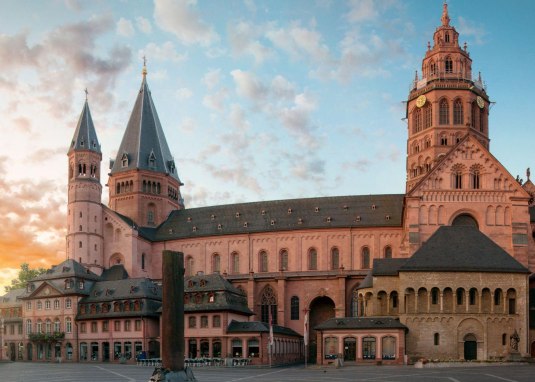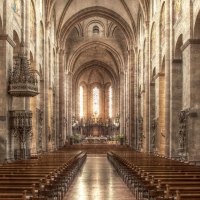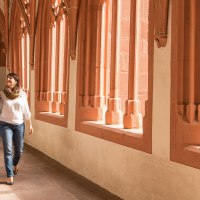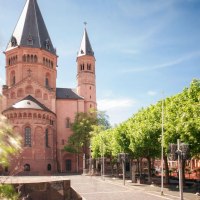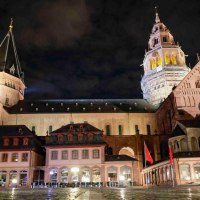"This cathedral above the Rhine valley would have remained in my memory in all its power and grandeur, even if I had never seen it again," wrote the writer Anna Seghers.
The immense cathedral still gives the city its face a thousand years after its construction, and it has shaped its history. Mainz, at the intersection of ancient trade routes, became the ecclesiastical center north of the Alps with the work of St. Boniface starting in 746/47; it received the title "Holy See" during the reign of Willigis (975-1011) in Mainz.
Willigis, Archbishop and also Imperial Chancellor of the Holy Roman Empire, laid the foundation stone for the cathedral in 975, designed after the model of St. Peter in Rome. Seven royal coronations took place in the Mainz cathedral over the centuries. However, the new building did not survive the day of consecration in August 1009 - a fire destroyed the structure, and the cathedral could only be used again in 1036. As a result, Willigis was buried in St. Stephen's. From his time comes the oldest preserved item of the Romanesque column basilica: the bronze doors of the market portal. The inscription of this ceremonial gate refers to the builder and the artist. The cathedral has three naves, two choirs, and numerous chapel extensions. The west choir with the main altar is dedicated to St. Martin, while the east choir is dedicated to St. Stephen.
The Mainz Cathedral is still framed by almost complete buildings. The "cathedral mountain," grown over the centuries from red sandstone, contrasts with the brightly colored Romanesque Gotthard chapel, which was built by Archbishop Adalbert before 1137 as a private chapel for the archbishops. There, a crucifix from the Staufer period is kept. On the cemetery court, Ignaz Michael Neumann, son of the famous Baroque master builder Balthasar Neumann, built the cathedral houses in 1778/79. He equipped them with fireproof stone roofs.
Seven times the cathedral has burned over the centuries, and the fear of fire was great. After a lightning strike, Neumann gave the western crossing tower a new spire in 1767, which references the gothic bell chamber in its forms. Again, stone was used for construction, not wood as before.
The east choir, with walls over two meters thick, is the oldest part of the cathedral. Its crossing tower was partially destroyed in 1793 by the bombardment of Mainz and was rebuilt at the beginning of the 19th century. City architect Georg Moller designed a round iron dome, which was later removed in favor of a historicizing pointed roof. A special feature is the capitels of the Virgin Mary portal, created around 1100 by Lombard stone masons. In the 19th century, a crypt from the 11th century style was discovered beneath the east choir.
The late Romanesque west choir was built between 1200 and 1239. Its crossing tower received a gothic bell chamber in the 15th century. The carved Rococo choir stalls from 1767 were saved from being sold off by Bishop Joseph Ludwig Colmar, who had been appointed by Napoleon. It was also Colmar who convinced the Emperor of the French not to demolish the cathedral after the secularization in 1803.
Since 1928, bishops have been buried in the new crypt beneath the west choir. Of the 84 bishops and archbishops that governed after Boniface, 45 are buried in the cathedral. Many memorials from the 11th to the 20th century are affixed to columns and walls of the church and the cloister. The often idealized depictions of the ecclesiastical dignitaries reflect the history of the Diocese of Mainz. Their completeness and good state of preservation make this portrait gallery one of the most important sights in the cathedral. Old wall and stained glass paintings are not preserved. The frescoes in the nave, based on designs by the Nazarene painter Philipp Veit, date from the previous century.
A point of attraction is the Marian altar in the Ketteler chapel with the "beautiful Mainzer." The late Gothic wooden figure group (around 1510) follows the sculptor Hans Backoffen, from whose workshop three memorials in the cathedral originate.
The cloister from the 15th century is two stories high. In the adjoining chapter buildings once lived the cathedral canons. Today, the Episcopal Cathedral and Diocesan Museum is located there. In the restored late Gothic exhibition rooms, religious art treasures from the late Middle Ages and modern times can be admired.
barrier-free access, cloister accessible via ramp, handicapped accessible restroom



